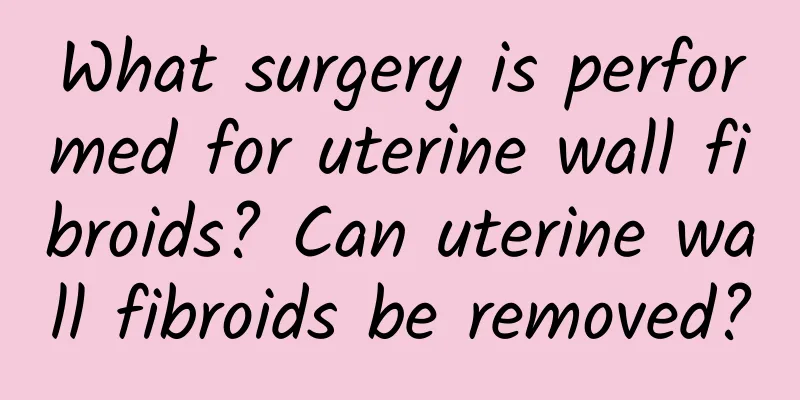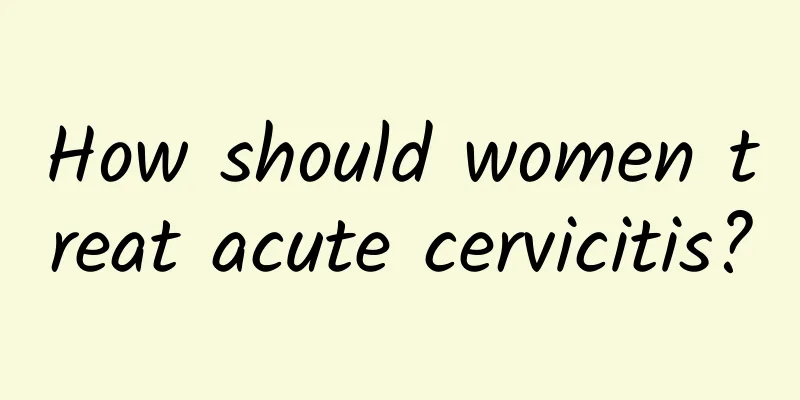What surgery is performed for uterine wall fibroids? Can uterine wall fibroids be removed?

|
What surgery is performed for uterine wall fibroids? Can uterine wall fibroids be removed? Uterine wall fibroids are a common female reproductive system disease that causes the uterine muscle wall to proliferate and form tumor-like objects. When the fibroids grow larger and cause symptoms, doctors usually recommend surgical removal. So, can fibroids on the uterine wall be removed? This article will introduce the surgery for uterine wall fibroids and its feasibility. 1. Resection is one of the main treatment options There are many treatment options for uterine wall fibroids, including medication, interventional therapy, and surgery. Surgical resection is one of the most common treatments. The surgery can be performed laparoscopically or laparotomy, depending on the location and size of the fibroids. 2. Feasibility of resection surgery Depending on the patient's specific situation, the doctor will assess the feasibility of the uterine wall fibroids. Usually, uterine wall fibroids are small and superficial, making them easy for surgeons to remove. The location and size of the fibroids have a greater impact on the success of the operation. If the fibroids are large or deep inside the uterine wall, the operation will be more difficult, but it is still feasible. 3. Laparoscopic surgery Laparoscopic surgery is a common method for removing uterine wall fibroids. The doctor makes a small incision in the abdomen or navel, inserts a laparoscope and other surgical instruments, and directly observes and removes the fibroids. This surgical method has the advantages of less trauma and faster recovery, and is suitable for some patients with small fibroids or superficial locations. 4. Laparotomy For some fibroids that are larger or deeper into the uterine wall, laparotomy may be necessary. Laparotomy is a procedure that allows direct visualization and removal of the fibroid through a laparotomy incision in the lower abdomen. Compared to laparoscopic surgery, laparotomy requires a larger incision and a longer recovery time, but it allows for a more complete removal of the fibroid. 5. Postoperative recovery and precautions Whether it is laparoscopic surgery or open surgery, recovery after surgery requires a certain amount of time and precautions. After surgery, you should follow the doctor's advice for recovery, including limiting activities, avoiding sexual intercourse, and regular checkups. You may experience some discomfort after surgery, such as pain and bleeding, but these symptoms usually gradually subside. During the postoperative recovery process, patients need to follow the doctor's advice and have regular checkups to evaluate their condition. Surgical removal of uterine wall fibroids is one of the main methods of treating the disease, which can be performed through laparoscopic surgery or laparotomy. Fibroids on the uterine wall can be removed, but the feasibility of the operation is affected by the size and location of the fibroids. It takes some time to recover after surgery, and the patient needs to follow the doctor's instructions for recovery and regular checkups. For the treatment of uterine wall fibroids, patients should actively communicate with their doctors and choose a treatment method that suits them. |
Recommend
How long does it take for abdominal pain to occur in ectopic pregnancy?
Abdominal pain usually occurs within 1-2 weeks af...
What cancer can uterine fibroids transform into? Can uterine fibroids transform into cancer?
Uterine fibroids are a common benign tumor in gyn...
Give him what he likes! 3 snacks to help children develop a balanced diet
What should I do if my child has a picky eating h...
What is missed abortion and what are its clinical manifestations?
Missed abortion is actually what is commonly know...
Is it painful for women to have abortion without anesthesia? Experts explain the common sense of female abortion
Abortion is a helpless act for every mother. Some...
Psychological care for threatened abortion
What is psychological care for threatened abortio...
What is the reason for yellow leucorrhea and odor? Vaginal infection
Abnormal vaginal discharge is usually caused by t...
Traditional Chinese medicine heating compress is effective in treating dysmenorrhea
Dysmenorrhea is not just mild pain during menstru...
Is it okay to eat low-calorie foods? Be careful, these 6 common weight loss foods make you hungrier the more you eat them
Lettuce salad, sugar-free green tea, agar-agar, s...
How to use medicine for acute pelvic inflammatory disease
How to use medicine for acute pelvic inflammatory...
What are the consequences of miscarriage? There are 4 major hazards
After a miscarriage, women are prone to secretion...
Abortion syndrome
The first step is to confirm the pregnancy. Accor...
What are the common causes of cervical precancerous lesions?
There are many reasons for cervical precancerous ...
What are the main causes of candidal vaginitis? What are the treatments for candidal vaginitis?
Vaginal candidiasis is mainly caused by Candida a...
Are you troubled by being overweight? Do these different exercises during the 4 stages of your menstrual period to double your weight loss effect
In addition to diet and exercise, weight loss is ...









